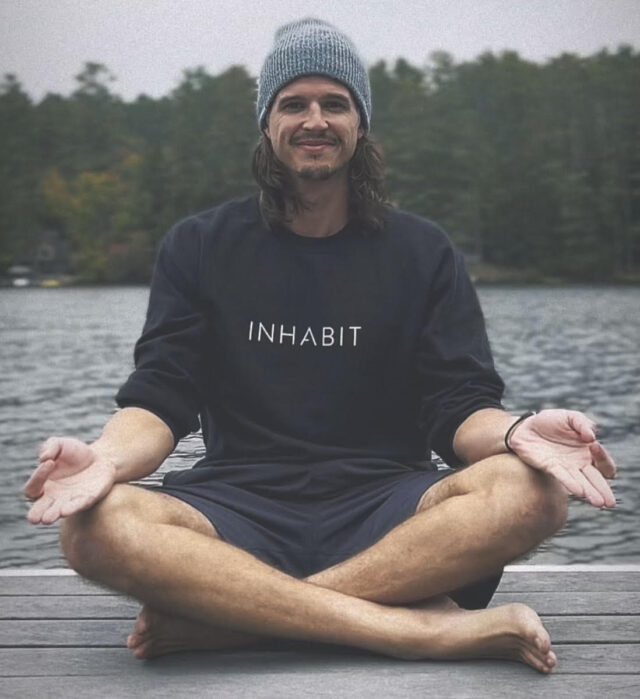
By Cristina Cuomo
Cristina Cuomo: You’re the founder and CEO of Inhabit, a wellness peak-performance company that serves schools, kids, businesses and sports organizations. It’s a mindfulness organization that you co-developed with your father to help people feel better and perform at their best. Your commitment to doing this inner work and helping people get it going daily is impressive. When did you start this organization?
Sean Pritchard: I originally founded the company in 2020 and then I recently brought my father on onboard as my co-founder as he’s been helping me to develop The Inhabit Method. He is one of my biggest inspirations and mentors. He actually was doing mental skills and team building in the early 2000s and helped my high school soccer team to win our first state championship. That was the early sign that I saw that there’s some real efficacy in getting the mind on point. My dad Gary is the man.
CC: When did you become a breath work instructor?
SP: About five years ago I started going deep into breath. I started off with the Wim Hof Method and did some training under them. Then that spiraled out into other training and certifications and I have now trained close to 4,000 people ranging from psychologists and therapists to youth and professional athletes, business people, working moms. Every day I help people with their breathing.
CC: When you led my Purist staff in a beautiful breath work session you said, “Not all breaths are created equal.” Can you share more about that idea?
SP: We take around 20,000 breaths roughly every day, but not all breaths are created equal. The way that we breathe has a massive impact on how we feel, how we perform, how we sleep. There are tens of trillions of cells in the body and all of those cells require oxygen. If you can improve oxygen delivery to each cell, you can create a huge impact on each function in the body. Just by changing the way that we breathe on a daily basis, not just when we feel stressed.
One of the biggest things that I look to help people with is going from a “let’s pull the emergency brake to de-stress” to “let’s be proactive and breathe properly on a consistent basis.” There are clear ways that you can optimize your breathing, and if you can create each breath with intention, you can elevate your wellness and performance.
CC: I love that, and I love that your company’s mission includes the inner workings of presence, being present, authenticity, kindness and gratitude, as we can’t enter a state of grace if we don’t have humility and gratitude. Resiliency is another value that you teach. These are beautiful values that we should all embrace. You’re focused on teaching a million people how to breathe properly. Tell me about that mission.
SP: It’s funny because we’re all breathing right now. If you’re watching this, you’re lucky enough to be alive and you’re processing that breath. We’re all breathing but not many of us are breathing properly. Studies have shown as high as 75 percent of adults struggle with dysfunctional breathing. And so one of the things that I’m really focused on is bringing proper breathing not only for adults—helping adults breathe better so that they can power their careers and help their families—but also kids. Two weeks ago, I was in North Jersey at one of my favorite clients called Harrington Park. They’re a wonderful preK-8th school. They have over 600 students and 70 teachers. We’re now going through our second year of bringing breath into the classroom and curriculum to help their kids and teachers thrive on a daily basis.

CC: How do we optimize our breathing, and what are some of the steps that you teach people to take?
SP: There are four components to proper breathing. First, I want folks to remember that your mouth is for eating and your nose is for breathing. As often as you can come back to those nasal breaths. What this is going to do is improve oxygen delivery anywhere from 10 percent to 20 percent into the blood. You’re going to get around six times as much nitric oxide that is being released from the sinuses, and what that does is it a bronchodilator so it opens up your airways and it’s also a vasodilator so it’s going to improve your blood flow because it’s dilating blood vessels.
Just from breathing through the nose, you’re going to get better oxygen delivery, improved blood flow and be healthier. A 2019 study found that nitric oxide is actually antiviral and antibacterial. So, when you’re breathing through your nose that’s the first line of defense.
Step two is to slow down your breathing. If you can breathe at a minimum of around five seconds on the inhale and exhale, that is a great indication that you’re breathing slowly enough to give that air enough time to get down to absorb in the lower parts of the lungs. So many of us are breathing too fast. When we breathe slowly, we get that air out of the dead space in the trachea and down to the lower parts of the lungs so it can be absorbed. Each human based on their size may have slightly different speeds that may be best for them, but just know that slow is certainly better.
CC: Before you get to steps three and four, when I interviewed James Nestor, who wrote the great Breath—and we’re waiting for your book by the way—he talks about a five count in and a five count out. What is your mode of breathing?
SP: That book and all of his work was incredibly inspiring for me when I was starting my company. Nestor changed my life. That five seconds in and out would fall under what is called coherent or resonant breathing. What I teach folks is around five seconds, too. Five seconds in and out, breathing slowly is the way to go.
CC: So, breathing through the nose, breathing slowly, figure out your count—five in and five out is pretty standard and an easy one to remember. Tell us the third and fourth steps.
SP: The third step is to breathe with the diaphragm in the belly region. Folks may be familiar with belly breathing via yoga. What’s fascinating is that most adults have very poor diaphragmatic activation and are only using around 10% of this essential muscle. There’s so much room for improvement there. When we breathe from the chest, for folks that may have ever experienced a panic attack or hyperventilation, what does that typically look like? Breathing from the mouth and upper chest. That is going to be way more on the sympathetic nervous system side, so releasing those stress hormones, adrenaline and cortisol. The antithesis of that, breathing from the diaphragm and the belly, breathing low, activates more of the parasympathetic side. It stimulates the vagus nerve, allowing the body to shift into that state where you lower your heart rate and blood pressure.
CC: Like a baby.
SP: One hundred percent. When babies are born, most of them breathe perfectly and then over time you get a manager, you get a mortgage and you start getting stressed and your breathing pattern changes. The diaphragmatic engagement will help to lower the heart rate and blood pressure, as well as supporting your back and lymphatic drainage.
The last one is breathing softly and quietly. This is interesting because you would think it would be the opposite. If I wanted to get a lot of air coming into my body you would think that if I took a big breath like this and I exhaled, I would get that air and bring it into the body. Science tells us the exact opposite, and this is work done from Konstantin Buteyko dating back even to the ’60s, which was detailed in Breath. What they talk about is that when you breathe softly, your CO2 levels will rise and your CO2 tolerance will rise. Thus, you’re able to actually deliver more oxygen to the cells. This is a concept called the Bohr Effect.
CC: How does the Inhabit Breathwork Technique differ from other breathing techniques?
SP: For folks that may be familiar with the Wim Hof Method or Tummo—those techniques are deep breathing combined with a breath hold. My technique takes deep breathing and a breath hold, and combines it with slow, soft nasal breaths at the end. For context on the nasal breath speed, Level 1 is 5 secs in/out and by Level 10, it’s 30 secs in/out. This technique is great for reducing stress, calming the mind and accessing peak performance.
My whole goal with this is to really train people to breathe softer and slower. I came up with this technique when I was looking at the animal kingdom. If you look at the animal kingdom and life expectancy, there’s some connection here, and pulmonologists and zoologists theorize that breathing speed could be, in fact, tied to life expectancy. If you look at whales or even specific types of moles, there are some moles that breathe slower and can hold their breath that live significantly longer than the same type of animal in a different part of the world that cannot breathe as slow or hold their breath.
CC: Why is combining breath work and visualization so powerful?
SP: I think of visualization on two levels. You have the first level, which is that you can use visualization as a way to improve a specific action or create an imprint on the mind. When you do breath work, what happens is you slow down your brain waves. Why is this powerful? Because when you move into alpha and out of beta, the subconscious is more open.
We know through research that around 95 percent of our day is driven by the subconscious mind. Thus, if you can slow down your brain waves via breath work and then visualize, you can deepen the imprint on your subconscious to more effectively create the change you’re looking for. Take for example a downhill skier. They are doing the Inhabit Breathwork Technique, pairing it with visualization, seeing themselves going through their run, hearing the sound of the snow on the skis, feeling the wind on their face. Bringing in all of the senses. The brain does not know the difference between real and imagined. The skier wants to make it as real as possible in their minds so that they execute that 55-second run exactly the way that they want to be able to improve their live performance. There’s the performati side and then the second level of this is how visualization aligns with the law of attraction and quantum mechanics. We shape our reality with our thoughts, beliefs, and actions. Visualization is an incredibly powerful tool for shaping the reality you desire.
CC: The great philosopher Marcus Aurelius said that thoughts create life. What you think is manifested in your life. You just shared the science behind that and it’s critical that people control that thought process.
SP: I couldn’t agree more. Marcus Aurelius is one of my favorites. I’m really into stoic philosophy. You can control what you can control.
Excerpted from this IG Live with Cristina Cuomo and Sean Pritchard.
Use special code PURISTBREATH for 50 percent off a 1:1 breathwork session with Sean and one month free on the Inhabit app. Visit inhabitmindbody.com to access these offers and check out their 10-Week Introductory Breath & Mindset Training Program.





